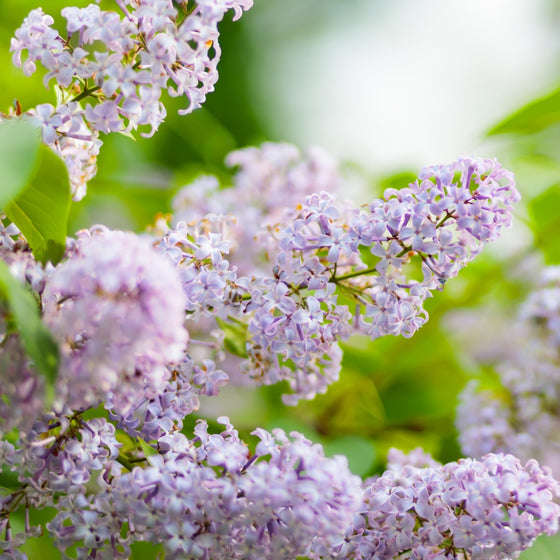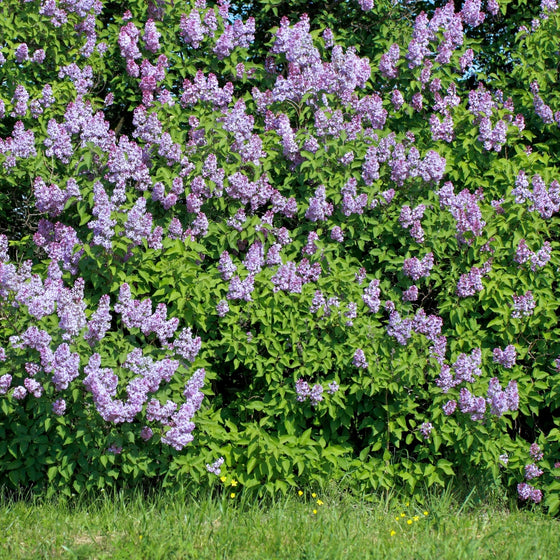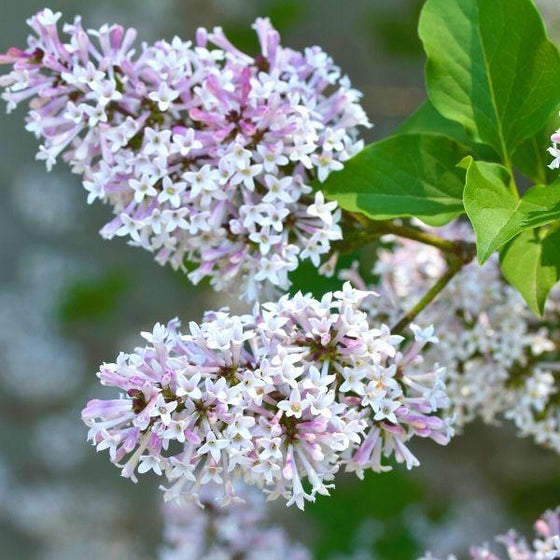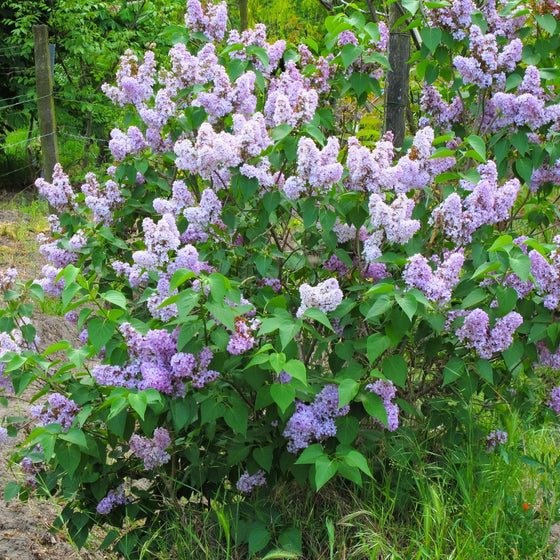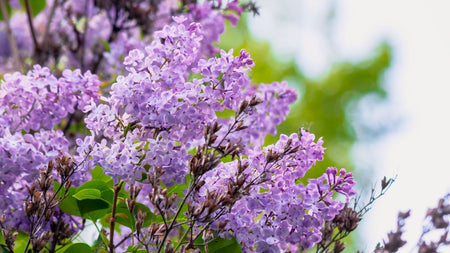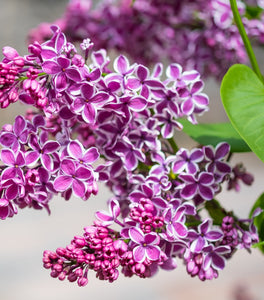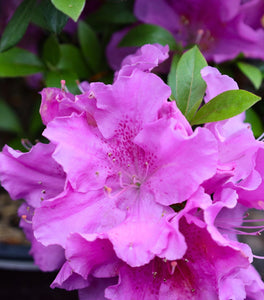
Images Depict Mature Plants
Miss Kim Lilac Shrubs
Lilac Miss Kim (Syringa pubescens subsp. patula 'Miss Kim') is a compact, cold-hardy deciduous shrub celebrated for its intensely fragrant, pale lavender to ice-blue blooms that appear in mid to late spring. Unlike traditional lilacs that bloom early, Miss Kim offers a later flush of color and scent, extending the lilac season in your garden. Its upright, rounded form reaches about 5 to 6 feet tall and wide, making it a perfect choice for smaller landscapes, foundation plantings, or mixed shrub borders where space is limited but fragrance and beauty are desired.
This easy-care lilac is prized not only for its aromatic blossoms but also for its excellent disease resistance and tidy growth habit. Miss Kim Lilac thrives in full sun and well-drained soil, and it tolerates a range of conditions including colder climates—flourishing in USDA Zones 3–8. In the fall, its dark green foliage turns a stunning burgundy-red, offering multi-season interest and making it a standout even after its blooms have faded. Its compact size also makes it suitable for planting near patios or walkways, where the sweet fragrance can be fully enjoyed.
Ideal for pollinator gardens and cottage-style landscapes, Lilac Miss Kim attracts butterflies and hummingbirds while resisting deer and tolerating urban pollution. Whether you plant it as a specimen shrub, in a hedge, or as part of a fragrant border, Miss Kim adds timeless charm and seasonal color to any garden setting. With its low maintenance needs and exceptional cold hardiness, it’s a dependable performer that brings long-lasting beauty and scent to your outdoor space.

| Hardiness Zone: | 4-8 |
|---|---|
| Mature Height: | 6 to 8 feet |
| Mature Width: | 6 to 8 feet |
| Classification: | Broad Leaved deciduous shrub |
| Sunlight: | Full Sun |
| Habit: | Upright, rounded habit |
| Foliage: | Dark Green, Burgundy in the Fall |
| Flower Color: | Lavender Blue, Very floriferous |
| Pruning Season: | No pruning needed |
| Soil Condition: | Any well drained soil |
| Water Requirements: | Water well until established |
| Uses: | Tolerates moist soil and full sun. Full sun brings out the best flowering. Will adapt to drier sites |
How to Care for Lilac Miss Kim
Be sure to read our planting instructions to ensure a healthy and happy Miss Kim Lilac plant for years to come!
How should I plant my Miss Kim Lilac?
To plant your Miss Kim Lilac (Syringa pubescens subsp. patula 'Miss Kim'), select a location that receives full sun—at least 6 hours per day—for the best bloom performance and healthy growth. This cold-hardy, compact lilac thrives in well-drained, slightly alkaline soil and does not tolerate wet feet. Begin by digging a hole twice as wide and just as deep as the root ball. Gently loosen the roots before placing the plant in the hole, making sure the crown is level with the surrounding soil. Backfill with native soil mixed with compost, tamp it down lightly, and water thoroughly to eliminate air pockets and help the roots settle. Space Miss Kim Lilac shrubs about 4 to 6 feet apart if planting as a hedge or in a mixed border to allow for good air circulation and proper development. Once planted, apply a 2- to 3-inch layer of mulch around the base, keeping it a few inches away from the stem to prevent moisture buildup and rot. This lilac is a great addition to foundation plantings, walkways, or patio areas where its sweet fragrance can be enjoyed in spring. With proper planting and positioning, Miss Kim Lilac will deliver years of fragrant blooms, attractive foliage, and dependable performance in cold-hardy landscapes.
How should I water My Miss Kim Lilacs?
Watering your Miss Kim Lilac properly is key to establishing strong roots and promoting vibrant blooms. During the first growing season, water deeply once or twice a week, depending on weather conditions, to keep the soil consistently moist but not soggy. Focus on soaking the root zone to encourage deep root development and avoid overhead watering, which can increase the risk of foliar diseases like powdery mildew. Morning watering is ideal, allowing the foliage to dry throughout the day. Once established, Miss Kim Lilacs are relatively drought-tolerant and only need supplemental watering during prolonged dry spells, especially in the summer months. In hot climates or sandy soils, be sure to check the soil moisture regularly and water when the top inch feels dry. A 2- to 3-inch layer of mulch around the base of the shrub helps conserve moisture and regulate soil temperature. Consistent, moderate watering not only supports healthy growth and flowering but also helps maintain disease resistance and overall plant vigor in sunny landscape settings.
How should I fertilize My Miss Kim Lilacs?
To fertilize your Miss Kim Lilac effectively, apply a balanced, slow-release fertilizer—such as a 10-10-10 formula—in early spring just as new growth begins. This helps support healthy foliage, strong stems, and abundant flower production. Spread the fertilizer evenly around the root zone, staying a few inches away from the base of the plant, and water it in thoroughly to help nutrients reach the roots. For gardeners who prefer organic options, compost or well-aged manure can also be worked into the soil in spring to naturally enrich the planting area. Avoid high-nitrogen fertilizers, as they can encourage excessive leafy growth at the expense of blooms. In most cases, one spring feeding is sufficient, especially if your Miss Kim Lilac is growing in rich, well-amended soil. If flowering seems weak or foliage appears pale, a light second application in early summer may help—but always follow label directions to avoid overfeeding. Proper fertilization, combined with good sun exposure and well-drained soil, will ensure your Miss Kim Lilac delivers fragrant, lavender-blue blooms and healthy, vigorous growth year after year.

How and when should I prune My Miss Kim Lilacs?
Pruning your Miss Kim Lilac should be done immediately after the shrub finishes blooming in late spring or early summer. Because lilacs bloom on old wood (growth from the previous season), pruning too late in the season will remove the buds for next year’s flowers. Start by cutting back spent flower clusters to encourage fresh growth and improve the shrub’s appearance. You can also remove any dead, damaged, or crossing branches at this time to improve air circulation and promote a strong, open structure that resists disease. Every few years, perform a more thorough rejuvenation pruning by removing about one-third of the oldest stems at ground level. This encourages new shoots and keeps the plant compact, especially important for maintaining the tidy shape of Miss Kim Lilac, which typically grows 5 to 6 feet tall and wide. Avoid shearing the plant, as it disrupts its natural form and may reduce blooming. With proper and timely pruning, your Miss Kim Lilac will reward you with fragrant lavender-blue blooms, dense foliage, and a healthy, attractive shape that enhances borders, foundations, and pollinator gardens.

